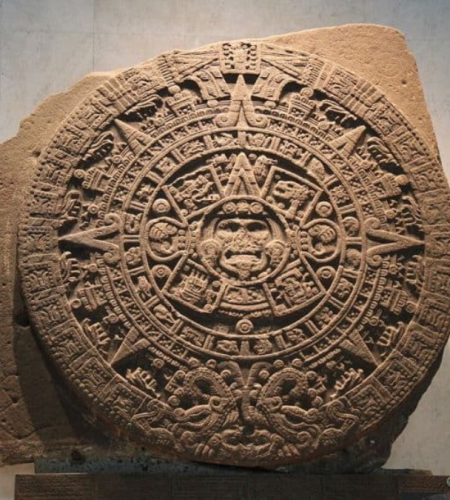The enduring strength of stone made it the preferred medium of expression for many ancient cultures. But for the civilizations of the pre-Columbian Americas, stone held much more than permanence. It was a sacred material—alive with energy, steeped in myth, and used to channel the power of deities, ancestors, and rulers. The legacy of these works has transcended their original settings, offering today’s scholars and collectors insight into a world where form and function merged with meaning.
From Mesoamerican temples to Andean mountaintop shrines, ancient Pre-Columbian stonework was a cultural, spiritual, and ceremonial cornerstone. From monumental to handheld, these works reflect sophisticated systems of knowledge, cosmology, and identity. For modern viewers and stewards, they invite not only admiration but deep reflection.
Material with Meaning: Why Stone Mattered
In the ancient Americas, stone was more than a readily available resource—a medium believed to embody living energy. Cultures from the Olmec to the Inca believed stone could transmit sacred force. This is one reason why so many of their most important artifacts—ritual figures, altars, masks, and effigies—were carved rather than painted or woven.
Among the Zapotecs and Veracruz, for example, ceremonial yokes and stone hachas were associated with the sacred ballgame and often buried as offerings. In the Colombian highlands, stone coca grinders and votive figures were placed in tombs, representing sustenance and spiritual transformation. Each region imbued its carved stone with culturally specific meanings, even while sharing the broader Pre-Columbian belief in the sacred nature of the material.
Today, the study and preservation of pre-Columbian sculptural artifacts allow us to reconstruct not only artistic techniques but belief systems—what people thought, feared, honored, and hoped for.
Iconography That Speaks Across Time
The imagery in Pre-Columbian sculpture is as layered as it is powerful. Mezcala figures from Guerrero emphasize abstraction and geometric harmony, suggesting a symbolic or ancestral purpose. By contrast, Maya stelae are rich with narrative and detail, often depicting rulers alongside glyphic texts that record historical or cosmological events.
Many of these stone objects were meant to be touched, viewed in ceremonial contexts, or even buried within architecture—literally part of the spiritual infrastructure. Their iconography often represents dualities: life and death, day and night, human and divine. Some carvings even align with astronomical events, tying artistic creation to the movement of time itself.
These symbols’ complexity and range are key reasons pre-Columbian stone figures continue to captivate modern researchers and collectors alike. The pieces serve not only as visual art but also as encoded language systems that offer a direct link to pre-Columbian worldviews.
Ethical Collection and Preservation Today
Modern galleries and collectors play an important role in preserving these artifacts when done ethically. Institutions like Galería ConTici are committed to responsibly stewardship of pre-Columbian artifacts, emphasizing documented provenance and respect for cultural origins. Their curatorial approach highlights the aesthetic value of stone carvings and their sacred and cultural dimensions.
For collectors, each piece carries a responsibility: to treat the object not merely as an artwork but as a cultural ambassador. Informed collecting can support education, scholarship, and even efforts toward cultural repatriation when appropriate. The goal is not just possession, but preservation of knowledge and respect.
This is why documentation, context, and expert collaboration matter so deeply. A genuine Pre-Columbian carving—especially one that has been studied and published—holds tangible and intangible value. Its legacy doesn’t end with acquisition; it continues through interpretation and ethical display.
Stone as Timeline and Testimony
When one stands before a pre-Columbian stone object, there is a sense of timelessness. These works have survived not only environmental erosion but colonial erasure, looting, and generations of neglect. What remains is testimony—proof that these civilizations were intellectually advanced, spiritually rich, and artistically sophisticated.
Whether it’s a stone figure from Peru’s Chavín culture, a Veracruz ceremonial effigy, or a Maya calendrical monument, each piece tells a story. Some of those stories are well-known, and others are still unfolding. With each scholarly article or gallery exhibit, our understanding deepens.
This is what makes ancient pre-Columbian stonework so essential—not only to art history but to the broader human story. These objects offer insight into how we once viewed time, divinity, power, and the cosmos. They are blueprints for belief, etched into the most enduring material available.
Conclusion
As our appreciation for Indigenous American art grows, so too does our responsibility to interpret and preserve it wisely. The study and collection of pre-Columbian sculptural artifacts, stone figures, and ancient pre-Columbian stonework are more than an academic or aesthetic pursuit—they are a form of cultural dialogue. By engaging with these objects thoughtfully, we help ensure that the traditions, voices, and visions they represent remain vibrant and alive.

